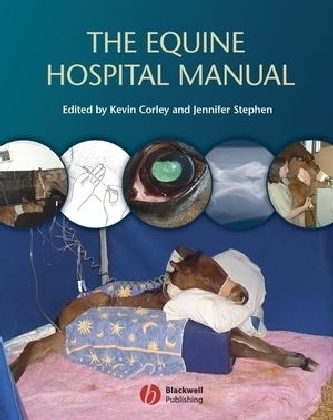
The Equine Hospital Manual
Wiley-Blackwell (Verlag)
9781405130165 (ISBN)
- Titel z.Zt. nicht lieferbar
- Versandkostenfrei
- Auch auf Rechnung
- Artikel merken
The Equine Hospital Manual covers the range of procedures used on hospitalized adult horses and foals from the simple to the advanced. The book is liberally illustrated with photographs and line drawings.
Covering:
Basic skills including physical examination, blood collection, and bandaging
Advanced skills including mechanical ventilation, lung biopsy and cardiac output measurement
Designing and setting up an equine hospital
Biosecurity
Therapeutic drugs used in horses and their doses
Nutrition for hospital patients, including TPN and PPN
Fluid therapy – choices, amounts and pitfalls
Anaesthesia – equipment, techniques and post-operative care including analgesia
Reflecting the substantial trend in recent years to treat horses in a hospital rather than in the field, this book provides all you need to know whether you have facilities to treat one or one hundred horses.
Kevin Corley and Jennifer Stephen are both based at Anglesey Lodge Equine Hospital, Republic of Ireland. Kevin was formerly a Lecturer in Equine Medicine and Critical Care, and Head of the Neonatal Foal Intensive Care Programme, at the Royal Veterinary College, London. He is an RCVS Recognised Specialist in Equine Medicine (Internal Medicine) and diplomate of both the American College of Veterinary Internal Medicine and the American College of Veterinary Emergency and Critical Care. He is widely published in equine internal medicine and critical care, and has spoken at a range of international conferences.
1. Procedures In the Adult Horse. 2. Procedures in the Neonatal Foal.
3. Hospital Design and Organisation.
4. Anaesthesia.
5. Nutritional Management of the Hospitalised Horse.
6. Common Treatments.
7. Common Problems Encountered in the Hospitalised Horse.
8. Monitoring and Treating the Coagulation System.
9. Monitoring and Treating the Cardiovascular System.
10. Monitoring and Treating the Respiratory System.
11. Monitoring and Treating the Gastrointestinal System.
12. Monitoring and Treating the Liver.
13. Monitoring and Treating the Urogenital System.
14. Monitoring and Treating the Neurological System.
15. Monitoring and Treating Common Musculoskeletal Problems in Hospitalised Horses.
16. Management of Horses with Problems of the Integument.
17. Monitoring and Treatment of Eyes.
18. Physiotherapy.
19. Appendices.
| Erscheint lt. Verlag | 13.6.2008 |
|---|---|
| Verlagsort | Hoboken |
| Sprache | englisch |
| Maße | 229 x 282 mm |
| Gewicht | 2295 g |
| Themenwelt | Naturwissenschaften ► Biologie |
| Veterinärmedizin ► Pferd ► Krankheitslehre | |
| ISBN-13 | 9781405130165 / 9781405130165 |
| Zustand | Neuware |
| Informationen gemäß Produktsicherheitsverordnung (GPSR) | |
| Haben Sie eine Frage zum Produkt? |
aus dem Bereich
